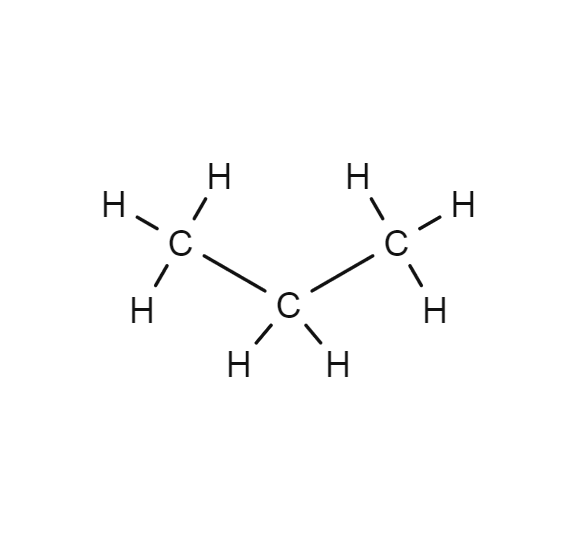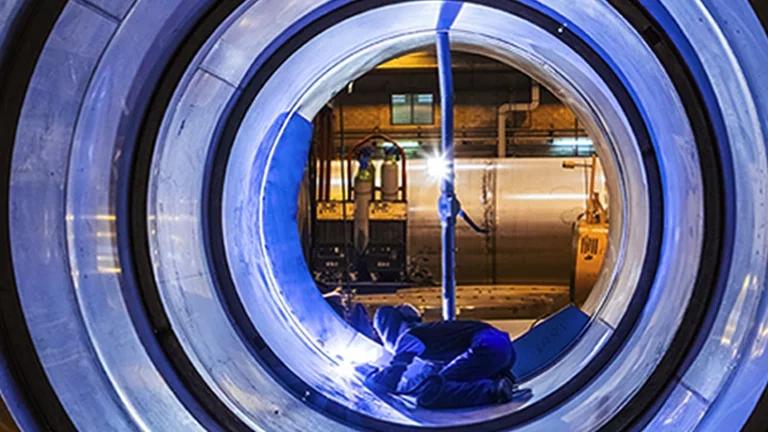
Propane
- C3H8
- CAS Number 74-98-6
- UN1978 (gas)
Click & drag to move the 3D molecule
Liquid / Gas Volumes
Calculate the volume or mass of a quantity of gas or liquid
Liquid Phase
At boiling point at 1.013 bar
Gas Phase
In standard conditions (1.013 bar, 15°C)
Physical Properties
Molecule phase diagram showing the transition phases between solid, liquid and gas as a function of temperature and pressure
-
- Molar mass 44.096 g/mol
- Content in dry air /
-
Critical Point
- Temperature 96.68 °C
- Pressure 42.48 bar
- Density 220.48 kg/m³
-
Triple Point
- Temperature -187.62 °C
- Pressure 1.7E-9 bar
Pressure 1.013 bar
| Latent heat of fusion (at melting point) | 79.917 kJ/kg |
| Melting point | - 187.68 °C |
Pressure 1.013 bar
| Boiling point | - 42.11 °C |
| Latent heat of vaporization (at boiling point) | 425.59 kJ/kg |
| Liquid density (at boiling point) | 580.88 kg/m3 |
| Compressibility factor Z | 9.7853E-1 |
| Cp/Cv ratio γ | 1.1504 |
| Gas density (at boiling point) | 2.416 kg/m3 |
| Gas density | 2.01 kg/m3 |
| Gas/(liquid at boiling point) equivalent | 289 vol/vol |
| Heat capacity Cp | 1.5841 kJ/(kg.K) |
| Heat capacity Cv | 1.377 kJ/(kg.K) |
| Specific gravity | 1.55 |
| Specific volume | 4.975E-1 m3/kg |
| Thermal conductivity | 15.65 mW/(m.K) |
| Vapor pressure | 4.749 bar |
| Viscosity | 7.4692E-5 Po |
| Compressibility factor Z | 9.8194E-1 |
| Cp/Cv ratio γ | 1.1416 |
| Gas density | 1.8988 kg/m3 |
| Gas/(liquid at boiling point) equivalent | 305.92 vol/vol |
| Heat capacity Cp | 1.6435 kJ/(kg.K) |
| Heat capacity Cv | 1.4396 kJ/(kg.K) |
| Solubility in water | 3.813E-5 mol/mol |
| Specific gravity | 1.55 |
| Specific volume | 5.267E-1 m3/kg |
| Thermal conductivity | 17.224 mW/(m.K) |
| Vapor pressure | 7.3239 bar |
| Viscosity | 7.8764E-5 Po |
| Compressibility factor Z | 9.8381E-1 |
| Cp/Cv ratio γ | 1.1364 |
| Gas density | 1.8316 kg/m3 |
| Gas/(liquid at boiling point) equivalent | 317.14 vol/vol |
| Heat capacity Cp | 1.6847 kJ/(kg.K) |
| Heat capacity Cv | 1.4825 kJ/(kg.K) |
| Solubility in water | 2.732E-5 mol/mol |
| Specific gravity | 1.55 |
| Specific volume | 5.46E-1 m3/kg |
| Thermal conductivity | 18.31 mW/(m.K) |
| Vapor pressure | 9.5326 bar |
| Viscosity | 8.1463E-5 Po |
Applications
Examples of uses of this molecule in Industry and Healthcare

Laboratories & Research Centers
Propane is used in calibration for environmental emission monitoring, industrial hygiene monitors and trace impurity analyzers, particularly for total hydrocarbons measurements (THC).

Metal fabrication
Propane is used in oxycutting.
Safety & Compatibility
GHS02
Flammable
Autoignition Temperature, Flammability Limits & Flash Point
Europe (according to EN1839 for Limits and EN 14522 for autoignition temperature)
| Autoignition temperature (Chemsafe) | 459 °C |
| Lower flammability limit (IEC 80079-20-1) | 1.7 vol% |
| Upper flammability limit (IEC 80079-20-1) | 10.8 vol% |
US (according to ASTM E681 for Limits and ASTM E659 for autoignition temperature)
| Autoignition temperature (NFPA 325) | 450 °C |
| Lower flammability limit (NFPA 325) | 2.1 vol% |
| Upper flammability limit (NFPA 325) | 9.5 vol% |
Threshold of toxicity
| PEL USA OSHA (vol) | 1000 ppm |
Odor
Faintly disagreeable
Metals
| Aluminium | Satisfactory |
| Brass | Satisfactory |
| Monel | No data |
| Copper | No data |
| Ferritic Steel | Satisfactory |
| Stainless steel | Satisfactory |
| Zinc | No data |
| Titanium | No data |
Plastics
| Polytetrafluoroethylene | Satisfactory |
| Polychlorotrifluoroethylene | Satisfactory |
| Polyvinylidene fluoride | Satisfactory |
| Polyvinyl chloride |
Significant swelling
Not recommended
|
| Ethylene tetrafluoroethylene | No data |
| Polycarbonate | No data |
| Polyamide | Satisfactory |
| Polypropylene | Satisfactory |
Elastomers
| Butyl (isobutene- isoprene) rubber |
Significant swelling
Not recommended
|
| Nitrile rubber | Satisfactory |
| Chloroprene |
Significant swelling
Not recommended
|
| Chlorofluorocarbons | No data |
| Silicone |
Significant swelling and modification of the mechanical properties
Not recommended
|
| Perfluoroelastomers | Satisfactory |
| Fluoroelastomers | Satisfactory |
| Neoprene | No data |
| Polyurethane |
Significant swelling
Not recommended
|
| Ethylene-Propylene |
significant swelling and modification of the mechanical properties
Not recommended
|
Lubricants
| Hydrocarbon based lubricant |
significant loss of mass
Not recommended
|
| Fluorocarbon based lubricant | Satisfactory |
Materials compatibility
Learn More
More information
Propane was first identified as a volatile component in gasoline by Walter O. Snelling in 1910. The "prop-" root found in "propane" and names of other compounds with three-carbon chains was derived from "propionic acid".